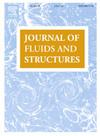装有交通护栏的非流线型桥面的 VIV 机制
IF 3.4
2区 工程技术
Q1 ENGINEERING, MECHANICAL
引用次数: 0
摘要
涡流诱导振动(VIV)在文献中主要针对大跨度桥梁的典型准流线型和浅π甲板截面,因为后者特别容易受风诱导振动的影响。与此相反,虽然全尺寸观测结果表明,与悬索桥和斜拉桥相比跨度较短的钢箱梁桥也会出现剧烈的 VIV 响应,但针对这些悬索桥截面几何形状的系统性研究却较少。此外,对于这种类型的桥梁,很少对非结构附加物(栏杆、屏风、整流罩)进行空气动力学优化。因此,我们对非流线型箱梁断面模型(受俄罗斯伏尔加格勒大桥启发)进行了风洞研究,该模型配备了两种类型的交通护栏,护栏高度与桥面宽度之比较大。考虑了实际的攻角范围(从 -3° 到 3°),并测量了静力、气动弹性振动和尾流速度波动。结果发现,振动振幅和锁定曲线模式的变化很大,甚至出乎意料,这说明可能存在相互竞争的激励机制。事实上,低孔隙率障碍物会改变涡流脱落的特性,特别是在甲板上部形成空腔,而众所周知,空腔会促进冲击剪切层不稳定性,就像在 H 型断面中一样。这种涡流脱落机制可能与卡尔曼涡流脱落同时存在,与静态试验中根据斯特劳哈尔数测得的预测结果相比,它可能是导致 VIV 发生时间大大提前的原因。次要激励机制的强度及其与主要机制的相互作用在很大程度上取决于攻角,并在很大程度上导致了 VIV 桥响应在定性模式和峰值振幅方面的深刻变化。在某些情况下,这些相互竞争的涡流曳引机制的轨迹甚至在测试桥梁模型的 VIV 响应曲线中清晰可见。最后,还根据准稳态理论对风洞结果进行了重新考虑,突出了一些甚至是定性的差异。本文章由计算机程序翻译,如有差异,请以英文原文为准。
VIV mechanisms of a non-streamlined bridge deck equipped with traffic barriers
Vortex-induced vibration (VIV) has been addressed in the literature mostly for quasi-streamlined and shallow π-deck sections, typical of long-span bridges, since the latter are particularly prone to wind-induced oscillations. In contrast, although full-scale observations demonstrate that even steel-box girder bridges, usually characterized by a shorter span length if compared to suspension and cable-stayed bridges, can experience a violent VIV response, systematic studies for these bluffer cross-section geometries are less frequent. In addition, the aerodynamic optimization of non-structural additions (barriers, screens, fairings) is rarely carried out for this bridge typology. Therefore, a wind tunnel investigation is conducted on a non-streamlined box-girder sectional model (inspired by the Volgograd Bridge, Russia) equipped with two typologies of traffic barriers giving rise to a large ratio of barrier height to deck width. A realistic range of angles of attack (from −3° to 3°) are considered, and static forces, aeroelastic vibrations and wake velocity fluctuations are measured. A large and even unexpected variability in the vibration amplitude and lock-in curve pattern is found, emphasizing the possible existence of competing excitation mechanisms. Indeed, low-porosity barriers can alter the characteristics of vortex shedding, in particular creating a cavity on the upper side of the deck, which is known to foster the impinging-shear-layer instability, as in H-shaped sections. This vortex-shedding mechanism may co-exist with Kármán-vortex shedding and may be responsible for significant anticipation of the VIV onset compared to the predictions based on the Strouhal number measured during static tests. The intensity of a secondary excitation mechanism and its interaction with the dominant mechanism strongly depend on the angle of attack and is largely responsible for profound changes in the VIV bridge response, both in terms of qualitative pattern and peak amplitude. In some cases, the tracks of these competing vortex-shedding mechanisms are even clearly visible in the VIV response curves of the tested bridge model. Finally, the wind tunnel results are also reconsidered based on the quasi-steady theory, highlighting some, even qualitative, discrepancies.
求助全文
通过发布文献求助,成功后即可免费获取论文全文。
去求助
来源期刊

Journal of Fluids and Structures
工程技术-工程:机械
CiteScore
6.90
自引率
8.30%
发文量
173
审稿时长
65 days
期刊介绍:
The Journal of Fluids and Structures serves as a focal point and a forum for the exchange of ideas, for the many kinds of specialists and practitioners concerned with fluid–structure interactions and the dynamics of systems related thereto, in any field. One of its aims is to foster the cross–fertilization of ideas, methods and techniques in the various disciplines involved.
The journal publishes papers that present original and significant contributions on all aspects of the mechanical interactions between fluids and solids, regardless of scale.
 求助内容:
求助内容: 应助结果提醒方式:
应助结果提醒方式:


